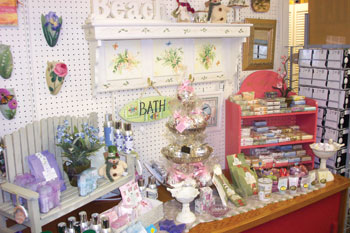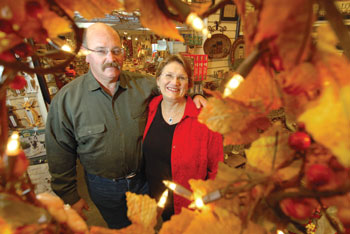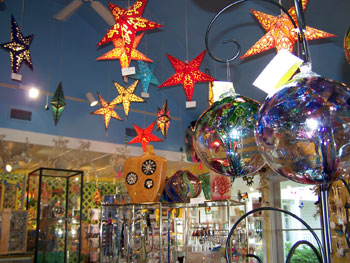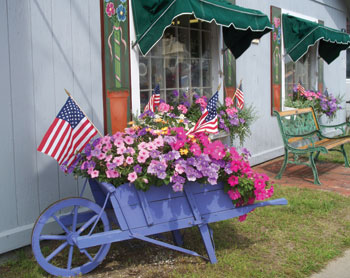A Season to Sell
Article Resources
Industry Experts
Doug Fleener
Dynamic Experiences Group
866.535.6331
DynamicExperiencesGroup.com
Lynn Switanowski-Barrett
Creative Business Consulting Group
617.437.9191
CBC-Group.net
Retailers
Nancy Kenney
Cottage Designs
Ocean Park, ME
207.934.4811
Cottage-Designs.com
Daniel Moore-Thompson
Suncatchers
Sanibel, FL
239.472.7860
SuncatchersDream.com
Peggy Pearson
Vermont Heritage Gifts and Crafts
802.253.7507
To everything there is a season. Anyone who has a store in a beach town or a ski resort knows that that statement surely includes retailing. Seasonal retailers may have stores in places where there is a lot of snow in the winter or colorful foliage in the fall or great ocean views in the summer but they all experience similar sales highs and lows depending on when the bulk of their customers want to be in the area. For some seasonal store owners, running a retail operation in an area where they do most of their business in just a few months out of the year offers a lot of advantages: an opportunity to live in a naturally beautiful area; the ability to take it easy for part of the year; and, the chance to become part of what is often an interesting, quirky, or unique part of the country.
There is also an opportunity to have a thriving retail business. But a seasonal retailer needs to pay careful attention to certain details—such as cultivating customers, predicting and managing inventory, and managing marketing campaigns and staffing—in ways that the year-round retailer does not.
“The short duration of the season is both a challenge and an opportunity for seasonal retailers,” says Doug Fleener, president of retail consulting firm, Dynamics Experiences Group, LLC, based in Lexington, MA. “The key to success for the seasonal retailer is to constantly adjust their strategy and tactics to meet the market conditions.”
Inventory issues
One of the most important and complicated aspects of a business strategy for seasonal retailers is managing inventory. According to Lynn Switanowski-Barrett, founder of Creative Business Consulting Group, a Boston-based retail consulting firm, seasonal retailers need to figure out not only how to predict their inventory needs but they also, thanks to a shorter sales cycle, need to determine when to start discounting their stock to ensure that it moves off the shelves in a timely way.
Nancy Kenney co-owns Cottage Designs, a gift shop in Ocean Park, ME, with her husband Cliff. The couple bought the store nearly seven years ago when they both decided to retire: She worked for HP and Cliff was a teacher. “We knew nothing about the gift shop business,” she says.
They learned quickly. Their inventory is an eclectic mix of gifts ranging from shot glasses to Christmas decorations to paintings, with nearly half of the 7,300 items priced under $10 and most of the rest of the items priced under $50. Kenney says that 75 percent of their business is done in July and August.
Kenney’s approach to purchasing inventory is a methodical one that is partly based on historical buying patterns and partly on instinct. For instance, this year she says she gambled by focusing on buying smaller items priced at under $20 because of the economic situation.
 Kenney buys a lot of her stock at the AmericasMart Atlanta Gift Show, and supplements with some custom products and some finds at local galleries. She says that she “uses” the spring, from mid-May to mid-June, to try to see what items are moving and she’ll order more of those. But she admits that it is not a perfect formula: Most of her pre- and post-season sales are to locals while the summer sales are to tourists.
Kenney buys a lot of her stock at the AmericasMart Atlanta Gift Show, and supplements with some custom products and some finds at local galleries. She says that she “uses” the spring, from mid-May to mid-June, to try to see what items are moving and she’ll order more of those. But she admits that it is not a perfect formula: Most of her pre- and post-season sales are to locals while the summer sales are to tourists.
Kenney says store sales have increased approximately 6 percent a year since they opened.
Fleener notes that historical traffic patterns are key for seasonal retailers trying to predict inventory. Another good resource for seasonal retailers without an established selling history is other retailers in non-competing marketplaces. Fleener recommends finding someone whose business is similar but in a different location. “You’ll get good information. It’s difficult to understand inventory if you are just starting out. Another retailer might be able to give you that,” he says. Vendors can also be helpful in giving seasonal retailers a sense of the amounts they should order. Fleener notes, though, that in general retailers should estimate conservatively when buying inventory.
“I’d rather scramble in season to get new inventory than be left with a lot of stuff,” he says. “One of the advantages of being a small retailer is they should be able to move faster to adjust to market conditions.”
 That is the secret of Peggy Pearson who owns Vermont Heritage Gifts and Crafts in Stowe, VT, with her husband Bill for the past 12 years. Vermont Heritage’s peak season is the fall, when tour buses pour into the town to look at the foliage. Business starts to slow down by Christmas and by the spring, “you could go bowling down Main Street and not get hit by a car,” says Pearson.
That is the secret of Peggy Pearson who owns Vermont Heritage Gifts and Crafts in Stowe, VT, with her husband Bill for the past 12 years. Vermont Heritage’s peak season is the fall, when tour buses pour into the town to look at the foliage. Business starts to slow down by Christmas and by the spring, “you could go bowling down Main Street and not get hit by a car,” says Pearson.
The store’s inventory mix is 30 percent jewelry, 15 percent leather goods and home accessories. Pearson’s strategy is to keep a lot of small-sized items in stock that people can carry in their suitcase. Most of the store’s goods are priced under $50, and the overwhelming majority range from $8 to $20.
Pearson says that she deals with vendors who can do quick turnarounds for her. She bases her purchases on previous buying trends but she adds that she is often on the phone with vendors in the middle of the season to get more stock.
 Daniel Moore-Thompson, who owns Suncatchers in Sanibel, Florida, a gift shop that sees most of its sales in the winter months with a secondary sales season in the summer, says that there is no excuse for a seasonal retailer’s best sellers to sell out. Suncatchers sells home décor and jewelry with most of the items priced under $50. Moore-Thompson’s focus is also on items that travelers can easily carry.
Daniel Moore-Thompson, who owns Suncatchers in Sanibel, Florida, a gift shop that sees most of its sales in the winter months with a secondary sales season in the summer, says that there is no excuse for a seasonal retailer’s best sellers to sell out. Suncatchers sells home décor and jewelry with most of the items priced under $50. Moore-Thompson’s focus is also on items that travelers can easily carry.
Moore-Thompson says he looks at the previous trends when purchasing new inventory and he’ll time his shipments with vendors based on what sold when in previous years. His winter crowd, he says, buys higher-priced items because it is more expensive to stay on the island then. The summer crowd is more of a souvenir crowd.
Moving inventory
Managing the movement of inventory can also get tricky for seasonal retailers. Switanowski-Barrett says that seasonal retailers need to be vigilant about inventory management.
“Many small stores don’t understand how to peak inventory, then how to liquidate,” says Switanowski-Barrett. “All summer stores have these huge peak seasons and then the customers are gone. Most stores don’t start thinking about liquidating until it’s too late.”
According to Switanowski-Barrett, seasonal retailers need to do both pre-season and end of season sales. She says that for instance, summer retailers understandably don’t want to give a discount in August when they can still sell an item at regular price because they might lose a few dollars off their margin. “But the small discount they give in August will be much better for cash flow in terms of the year,” she points out.
 If retailers are really worried about discounts, they can get creative. Offering a gift with a purchase is one option, says Switanowski-Barrett. “You just want to move slow-moving items and excess inventory. It’s all about planning,” she says. “For retailers, the biggest expense is inventory and you already paid the vendor. You are losing money when the cash is tied up on the shelves.”
If retailers are really worried about discounts, they can get creative. Offering a gift with a purchase is one option, says Switanowski-Barrett. “You just want to move slow-moving items and excess inventory. It’s all about planning,” she says. “For retailers, the biggest expense is inventory and you already paid the vendor. You are losing money when the cash is tied up on the shelves.”
Fleener agrees. “I like to say we’re in the stock market and if your stock is boxed up for eight months that’s your cash tied up,” he says.
Fleener recommends that seasonal retailers sell their stock at a huge discount at the end of the season.
Switanowski-Barrett adds that there is an option for seasonal retailers of negotiating purchases from vendors, especially on the last shipment. “Nobody should pay regular price for that last shipment,” she says.
Pearson says that for fall foliage “the buses will always come. People plan their vacations to Vermont during foliage many weeks ahead. So even if it rains, they’re here and want something to do, and they shop.” But she starts discounting her seasonal items by the end of October. The seasonal corner quickly becomes her Christmas corner but most of the holiday traffic is local so she drums up business by sending out flyers and putting the store’s jewelry on sale. She also runs special sales for hunting season, for Valentine’s Day, and advertises on local radio stations to try to get buyers from neighboring towns to come in. A bubble machine outside her shop has proved effective in providing the store with some local distinction. “We’re known as the bubble store,” says Pearson.
Kenney says she always has some excess inventory which goes on sale the following spring. Otherwise, it gets donated to a local charity, which is important to Kenney who makes a concerted effort to become part of the local community. She and her husband even made a point of keeping the store open through Christmas so they can host Christmas parties for local seniors. “We don’t do a lot of business in December but I consider it giving back to the community,” says Kenney.
Erratic traffic flow?
Kenney drums up business in the quiet time by advertising in the local Chamber of Commerce’s map and booklet and leaving fliers in area restaurants.
 Moore-Thompson’s Suncatchers has also become part of the fabric of the Sanibel Island community and it’s that fact that enables him to keep the store open all year round. “The locals are floating the store in between busy times,” he says. “Otherwise we would close for certain periods. We get people from the mainland who come out here because they love the store. It’s become a social hub. People like to come in and talk.”
Moore-Thompson’s Suncatchers has also become part of the fabric of the Sanibel Island community and it’s that fact that enables him to keep the store open all year round. “The locals are floating the store in between busy times,” he says. “Otherwise we would close for certain periods. We get people from the mainland who come out here because they love the store. It’s become a social hub. People like to come in and talk.”
But all seasonal retailers don’t see a good portion of their customers for a good part of the year, whether they stay open all year or not. Switanowski-Barrett says that one of the most important things a seasonal retailer can do is keep in touch with their customers all year through e-mail blasts or cards. “You can still communicate with people even if most of your customers aren’t there,” she says. “Don’t stop marketing and reminding people about what you do. Many of these stores have niche products and can sell products over the Web or the phone.”
This is especially true with stores like Cottage Designs, where Kenney says that most of the people have been coming year after year for generations. “We get to know them,” she says. “It’s like they’re extended family.” Even many day trippers come back every year to the store, she says.
For many seasonal stores, the tourist traffic does not always produce returning customers. Switanowski-Barrett recommends that seasonal retailers partner with a non-competing business that is open all year long so they can have access to a larger database of customers. A seasonal gift shop with whom Switanowski-Barrett once worked had 1,000 customers on its e-mail list. The store made an arrangement with the local hotel to create and sell an exclusive ornament for the hotel. “Now they have a list of 10,000 people,” says Switanowski-Barrett indicating that the name recognition the store received, was invaluable. “So many more people know about their store.”
Seasonal staffing
It is often a seasonal retailer’s family that solves a lot of staffing issues. Kenney’s daughter helps her out in the store when it gets very busy. Pearson has a number of local seniors who are willing to work on a flexible part time basis. Moore-Thompson also relies on the flexibility of his part-time employee and can afford an additional full-time employee.
But Fleener says that for most seasonal retailers, staffing is a big issue. “A lot of seasonal retailers are competing against other businesses looking for help,” he says. “Staff can be just as challenging as inventory.” According to Fleener, a seasonal retailer needs to think about how they can attract staff whether it’s by offering flexibility or later hours.
At nature’s mercy?
 A seasonal retailer is also heavily dependent upon the weather to ensure a good season—but Mother Nature does not always cooperate. Retailers, notes Fleener, need to keep that in mind when ordering inventory. “If bad weather hits or there’s not enough snow, don’t put yourself so far out there that if you have two bad weeks, you’re broke,” he says.
A seasonal retailer is also heavily dependent upon the weather to ensure a good season—but Mother Nature does not always cooperate. Retailers, notes Fleener, need to keep that in mind when ordering inventory. “If bad weather hits or there’s not enough snow, don’t put yourself so far out there that if you have two bad weeks, you’re broke,” he says.
Pearson knows that all too well. While her peak season traffic, the fall, is almost never affected by weather or other catastrophes, her winter traffic is. “We had a horrible winter two years ago with very little snow,” she says. “Even though we don’t plan on much business during the winter months, we lost 25 to 40 percent of the little we usually do get, so that hurt. We usually pay off our credit line after foliage and don’t dip into it again until we bring in our new merchandise for the next summer. That year, we had to dip into our credit line just to make it through the winter.” Pearson adds that in 2001, they worried how the store would be affected by 9/11, “but we had a normal fall,” she says.
Despite the unique challenges of running a seasonal retail store, those involved appreciate the ability to make a living on their own terms. Just ask Kenney, who spends the month of February on a Caribbean Island every year with her husband. Then there’s Moore-Thompson, who spent eight years working for Pier One Imports and went to work in a suit and tie every day. “Now I come to work in my Birkenstocks,” he says.























